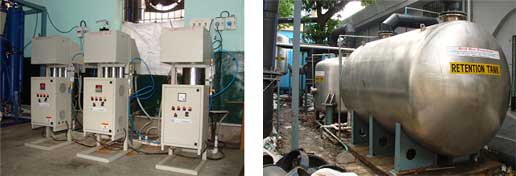The Swimming Pool Water Treatment has to undergo the following treatment steps.
Step 1: Pre Ozonation
The principal purpose of pre ozonation is to improve the coagulation and filtration stage of the treatment. Advantages of pre ozonation are:
• Oxidation of high organic levels, Iron and manganese for better coagulation and filtration without producing any disinfectant by-products (DBPs) like Trihelomethane.
• Reduced use of coagulation agents (up to 50%)
• Improved sedimentation and flotation characteristics
More effectively destroys Bacteria, Viruses, Fungi, and Algae & Spores.
Ref : DIN 19643 – 3 Treatment and disinfection of water in bathing facilities.
Recommended ozone dose prior to filtration = 1.0 to 1.5 mg/l
Ozone Generator Capacity = 450 m3/hr x 1.5 mg/l= 675 gm/hr
Step 2 ) Pre – Filtration
Recirculation system shall include a pre-filtration system like hair lint strainer to prevent hair, line and foreign objects from reaching the pump and filters. This will prevent such physical impurities chocking filtration mechanism and increasing pressure on pump which may causes breakdown demanding maintenance.
Basket Strainer Flow Rate = 450 m3/hr x 01 no.
Step 3) ±pH Dosing
For satisfactory coagulation and adequate disinfection with the lowest possible consumption of disinfectant, the ± pH value of the swimming pool water shall be adjusted and can be fed into the system by metering pump or by hand. Soda ash (Sodium Carbonate) is used as the pH raise chemical and dosed in water with the help of electronic metering pump as required.
A typical reaction of soda ash may be expressed as:
Na2CO3 + H2O 2NaOH + CO2
Muriatic acid (Hydrochloric acid) is used as the pH decrease chemical and dosed in water with the help of electronic metering pump as required.
A typical reaction of muriatic acid may be expressed as:
HCl + H2O H3O+ + Cl−
± pH Dosing Pump Capacity : 0 – 12 LPH
Pressure : 0 – 9 Kg/cm2
A metering pump and ±pH dosing tank is used to dose suitable acid or alkaline chemicals into the pool water.
Ref: DIN 19643 – 3 Treatment and disinfection of water in bathing facilities.
Step 4) Coagulant Dosing
Aluminum Sulphate is used as a coagulant. The Alum is dissolved in water to form a solution that can be fed into the system by metering pump or by hand. To achieve satisfactory coagulation, the pH of the pool water should be maintained between 7.2 and 7.6; otherwise the Alum may move through the filter and turn the pool water into a milky looking condition, which is undesirable.
Coagulation is a time rate process; the time provided for flocculation to occur is also significant factor. A coagulation time of 30 seconds is provided in the coagulation tank.
A typical reaction of alum may be expressed as:
Al2 (SO4)3. 18 H2O 2 Al3+ + 3 SO4- + 18 H2O
2 Al3+ + 6 OH- Al2O3 . x H2O
Flocculation Tank Capacity : 450 m3/hr x 30 sec 3600
= 3.75 m3
Ref :DIN 19643 – 3 Treatment and disinfection of water in bathing facilities.
Step 5) Coarse Filtration
Filtration plays an essential part in achieving the perfect swimming pool. No matter what chemicals are used, without an efficient filter the pool water can never be kept clean. A good filtration is the heart of the circulation system. Effective circulation and filtration of swimming pool water is essential for clear, clean water. Well designed filtration ensures efficient removal of particulates (suspended solids) and effective distribution ensures application of residually disinfected water uniformly throughout the pool. Poor circulation leads to dead spots of poor quality water. The purpose of the filter is to remove foreign materials such as dust, algae etc. from the pool. Filter will get clogged up periodically. This will show on the filters pressure gauge. When this happens the filter must be cleaned in order to continue operating efficiently.
Filtration Flow Rate : 450 m3/hr
Micron size : 50 micron
Step 6) Post – Ozonation
The principle of proper post ozonation operation by treating a smaller percentage of the water flow and properly mix the ozone and water by proving a sufficient contact (retention) time for complete disinfection. A proportion of the water to be treated should be drawn off by suitable (side stream pump) and fed under pressure to the nozzle of the venturi. Venturi injectors work by forcing water through a conical body which initiates a pressure differential between the inlet & outlet ports. This creates a vacuum inside the injector body, which initiates ozone suction through the suction port. Venturi injectors do attain fairly good mass transfer by using a static mixer greatly improves mass transfer efficiency up to 90 to 95%. The resultant gas/mixture is then fed into an ozone retention tank. A ozone contact time of 120 seconds is provided in the ozone retention tank to complete disinfection after addition of ozone gas.
Recommended ozone dose after filtration = 0.8 to 1.0 mg/l
Ozone Generator Capacity = 450 m3/hr x 1.0 mg/l = 450 gm/hr
Ozone Retention Tank Capacity: 450 m3/hr x 120 sec
3600
= 15 m3
Side Stream Pump : Considered 10% side stream flow rate 45 m3/hr.
Ref: NSW – HEALTH (Department of Health NSW Public Swimming Pool and Spa Pool Guidelines) June 1996.

|

